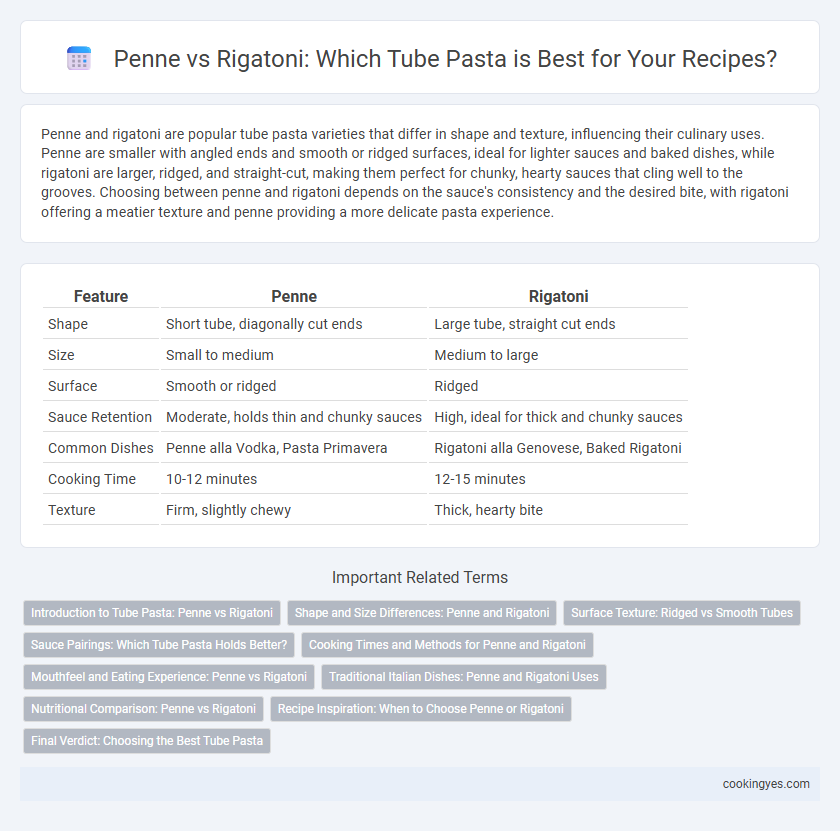Penne and rigatoni are popular tube pasta varieties that differ in shape and texture, influencing their culinary uses. Penne are smaller with angled ends and smooth or ridged surfaces, ideal for lighter sauces and baked dishes, while rigatoni are larger, ridged, and straight-cut, making them perfect for chunky, hearty sauces that cling well to the grooves. Choosing between penne and rigatoni depends on the sauce's consistency and the desired bite, with rigatoni offering a meatier texture and penne providing a more delicate pasta experience.
Table of Comparison
| Feature | Penne | Rigatoni |
|---|---|---|
| Shape | Short tube, diagonally cut ends | Large tube, straight cut ends |
| Size | Small to medium | Medium to large |
| Surface | Smooth or ridged | Ridged |
| Sauce Retention | Moderate, holds thin and chunky sauces | High, ideal for thick and chunky sauces |
| Common Dishes | Penne alla Vodka, Pasta Primavera | Rigatoni alla Genovese, Baked Rigatoni |
| Cooking Time | 10-12 minutes | 12-15 minutes |
| Texture | Firm, slightly chewy | Thick, hearty bite |
Introduction to Tube Pasta: Penne vs Rigatoni
Penne and rigatoni are popular tube pasta varieties distinguished by their shape and texture, impacting sauce adherence and dish versatility. Penne features smooth or ridged diagonally cut tubes that are ideal for lighter sauces and baked dishes, while rigatoni's larger, ridged straight tubes trap thicker, meatier sauces inside. Understanding these differences enhances the selection of pasta based on recipe requirements and desired flavor absorption.
Shape and Size Differences: Penne and Rigatoni
Penne pasta features smooth or ridged cylindrical tubes cut at an angle, typically measuring about 1.5 to 2 inches in length and narrower in diameter compared to rigatoni. Rigatoni is larger, with wider, ridged tubes cut straight across, often measuring up to 2 inches or more in length and providing a more substantial bite. The shape and size variations influence sauce adherence and texture, with penne's angled ends enhancing sauce capture and rigatoni's larger surface area ideal for chunkier sauces.
Surface Texture: Ridged vs Smooth Tubes
Penne and rigatoni differ notably in surface texture, with penne featuring ridges along its smooth, angled tubes that enhance sauce adhesion and create a balanced mouthfeel. Rigatoni's larger diameter and pronounced ridges offer a more robust texture, allowing it to hold thicker sauces and chunky ingredients more effectively. Both types utilize their ridged surfaces to maximize flavor absorption, but rigatoni's size and deeper grooves provide a heartier bite ideal for hearty, meat-based sauces.
Sauce Pairings: Which Tube Pasta Holds Better?
Penne's smooth, angled tubes excel at capturing lighter sauces like primavera and olive oil-based blends, allowing for even coating without overpowering the pasta. Rigatoni features larger, ridged tubes that trap chunky, meaty sauces such as Bolognese or sausage ragu, providing a hearty bite with every forkful. Choosing between penne and rigatoni depends on sauce texture and density, with rigatoni better suited for robust, thick sauces and penne ideal for lighter, thinner ones.
Cooking Times and Methods for Penne and Rigatoni
Penne typically requires 9 to 11 minutes to cook until al dente, while rigatoni takes slightly longer, around 12 to 14 minutes due to its larger diameter and thicker walls. Both pasta types benefit from boiling in rapidly boiling salted water, but rigatoni's ridged surface and hollow tubes allow it to hold thicker sauces better during simmering or baking methods. To achieve optimal texture, penne is often preferred for quick sauteing with light sauces, whereas rigatoni excels in baked pasta dishes requiring extended cooking times.
Mouthfeel and Eating Experience: Penne vs Rigatoni
Penne offers a firm bite with its smaller, smooth tubes that hold sauce evenly, creating a balanced mouthfeel ideal for lighter dishes. Rigatoni, with its larger diameter and ridged exterior, provides a hearty texture that enhances sauce adherence and delivers a more robust chewing experience. The ridges and wider opening of rigatoni intensify the pasta's grip on chunky sauces, making each bite rich and satisfying compared to penne's streamlined texture.
Traditional Italian Dishes: Penne and Rigatoni Uses
Penne and rigatoni are staple tube-shaped pastas in traditional Italian cuisine, each suited to distinct dishes due to their shape and texture. Penne, with its smooth or ridged surface and angled ends, excels in capturing lighter sauces like pesto or creamy vodka sauce typically found in dishes such as Penne alla Vodka. Rigatoni, larger and ridged with straight edges, holds up well to hearty, chunky sauces and baked preparations, making it ideal for classics like Rigatoni alla Norma or baked rigatoni casseroles.
Nutritional Comparison: Penne vs Rigatoni
Penne and rigatoni pasta both offer similar nutritional profiles, with comparable calorie counts, carbohydrate content, and protein levels per serving. Penne typically has a slightly lower glycemic index due to its thinner shape, promoting steadier blood sugar levels. Rigatoni's larger, ridged tubes hold more sauce, often adding extra calories and sodium depending on the dish's preparation.
Recipe Inspiration: When to Choose Penne or Rigatoni
Penne's slender, angled tubes excel in lighter sauces like arrabbiata or pesto, allowing flavors to cling within their ridged surface for a balanced bite. Rigatoni's larger, ridged tubes are perfect for hearty meat or cheese sauces, as their wide openings capture chunky ingredients, enhancing texture and flavor depth. Recipe inspiration suggests choosing penne for quick, elegant dishes and rigatoni for comforting, robust meals that require sauce retention and substantial mouthfeel.
Final Verdict: Choosing the Best Tube Pasta
Penne offers a versatile shape with smooth or ridged surfaces ideal for capturing lighter sauces, making it perfect for quick, simple meals and baked dishes. Rigatoni's larger, ridged tubes hold thicker, chunky sauces better, providing a hearty texture suited for robust recipes like ragu or baked casseroles. Selecting the best tube pasta depends on sauce consistency and dish type, with penne favored for delicate flavors and rigatoni excelling in rich, meat-heavy preparations.
Penne vs Rigatoni for tube pasta Infographic

 cookingyes.com
cookingyes.com